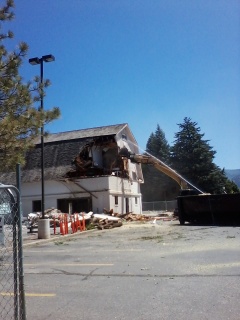About five years ago, I got involved in the preservation effort for the Art Barn at Utah State University. The Art Barn dates to 1919, when it was built as a horse barn to serve the campus (then the Agricultural College of Utah, the state’s land grant college). This was during the time that the campus was doubling as a military base for World War I and growing rapidly. The barn served its agricultural purpose for many years until the animals were moved from campus. Then the Art Department adopted the abandoned building, and it became the Art Barn until recent years when it fell into disrepair. It had a colorful history, which you can read about at the USU Barn Blog.
The last news I heard of the Art Barn was that Utah State University and USU Credit Union were working together to turn the building into offices and a welcome center. A respectable use for a respectable old building, once the plans to turn it into a museum fell through. So when I drove through campus today and saw construction work going on–the building gutted–I assumed the restoration had begun. Excited, I pulled up and waved over one of the construction workers.
“How much of the exterior are you going to be able to save? Are you going to save the sign?” I pointed to the “Man’s Best Friend” sign over the old front doors of the stable–supposedly an old cavalry motto referring to horses, not dogs.
He scratched under his orange hat. “They made a cast of the sign to display somewhere on campus. It was cracked in three places and couldn’t be moved.”
“You’re not keeping the sign?” My heart fell. That sign was a unique reminder of the confluence of agricultural and military history at USU.
“Nope. The whole thing has to be renovated.”
I thanked him and backed away, making notes to make some phone calls, find out what the plans were for the building. As I stood watching, one of the guys got into the tractor and slammed the excavator into the beautiful gambrel roof, crushing the corner of the building. I stared, my hand over my mouth, as they did it again and again, stripping away the front of the building.
Not renovated, razed.
In its last moments, the building proved the worth of its construction. It did not go gentle into that good night, didn’t buckle under the blows. Tears slid down my face as I watched the destruction of all that history, all those memories. I felt a small amount of what a person must experience when they go to see a condemned friend stand in front of a firing squad. It was horrible to watch, but I was glad someone was there who understood what the building had been, to capture its final moments and bid it farewell.
There are occupations more heartbreaking than historic preservation, but trying to save the past is an exercise in futility, digging moats around sandcastles as the tide is coming in. That doesn’t stop people who love history from trying, but as I got into my car, Tennyson’s words played over and over in my mind: “All things must die.” Then I remembered that he wrote a more hopeful mirror poem to that despairing one, with the refrain: “All things will change.”
I think everyone who loves history–who loves historic places–can take comfort in the words of Joshua Lawrence Chamberlain when he spoke of the great power places have to speak to people, to bridge time despite all the changes on the surface:
“In great deeds, something abides. On great fields, something stays. Forms change and pass; bodies disappear; but spirits linger, to consecrate ground for the vision-place of souls.”




